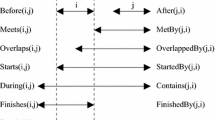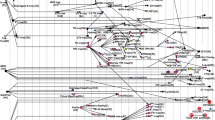Abstract
Nowadays, two of the main challenges involving spatio-temporal databases concern the integration of their spatial and temporal features to store and query spatial objects changing over time, and the development of a simple and friendly language to query spatio-temporal data. In this paper we gather these two challenges by proposing Moving GeoPQL, a language defined in order to express spatio-temporal queries, extending the Geographical Pictorial Query language (GeoPQL). The proposed evolution is based on the concept of temporal layer that allows specifying the spatial configuration of moving objects in a time interval. More layers allow representing changes in terms of spatial configurations. Some examples of query formulation and system operation are described in the article. Finally, an experiment has been carried out for evaluating the usability of the Moving GeoPQL system. Results of this experiment showed that it facilitates the spatio-temporal query formulation since it is more user-friendly and ease to use compared to textual query languages.
















Similar content being viewed by others
Notes
The path of a moving point ψ is specified by an oriented polyline, representing the start_point, start_time, the end_point and the end_time of ψ.
References
Abraham T, Roddick JF (1999) Survey of spatio-temporal databases. GeoInformatica 3(1):61–99
Allen JF, Ferguson G (1994) Actions and events in interval temporal logic, Technical Report 521
Aufaure-Portier M-A, Bonhomme C (1999) A high level visual language for spatial data management, 3rd International Conference on Visual Information Systems (Visual’99), Amsterdam, The Netherlands, 2–4 June
Barnum CM (2002) Usability testing and research. Longman, New York
Blaser AD, Egenhofer MJ (2000) A visual tool for querying geographic databases. Advanced Visual Interfaces – AVI 2000. ACM Press, Palermo, pp 211–216
Bonhomme C, Aufaure-Portier M-A, Trépied C (2000) Metaphors for visual querying spatio-temporal databases. Proceedings of the 4th International Conference on Advances in Visual Information Systems, pp 140–153
Calcinelli D, Mainguenaud M (1994) Cigales, a visual language for geographical information system: the user interface. J Vis Lang Comput 5(2):113–132
Downey LL (2007) Group usability testing: evolution in usability techniques. Journal of Usability Studies 2(3):133–144
D’Ulizia A, Ferri F, Formica A, Grifoni P (2009) Approximating geographical queries. J Comput Sci Tech 24(6):1109–1124
Eden B (2005) 3D visualization techniques: 2D and 3D information visualization resources, applications, and future. Library Technical Reports, 41, no. 1
Egenhofer MJ (1997) Query processing in spatial-query-by-sketch. J Vis Lang Comput 8(4):403–424
Egenhofer MJ, Richards JR (1993) Exploratory access to geographic data based on the map-overlay metaphor. J Vis Lang Comput 4:105–125
Erwig M, Güting RH, Schneider M, Vazirgiannis M (1999) Spatio-temporal data types: an approach to modeling and querying moving objects in databases. GeoInformatica 3(3):269–296
Erwig M, Schneider M (2000) Query-by-Trace: visual predicate specification in spatio-temporal databases. In: Arisawa H, Catarci T (eds) Advances in visual information management—visual database systems. Kluwer, Boston, pp 199–218
Erwig M, Schneider M (2003) A visual language for the evolution of spatial relationships and its translation into a spatio-temporal calculus. J Vis Lang Comput 14:181–211, Elsevier
Ferri F, Rafanelli M (2005) GeoPQL: a geographical pictorial query language that resolves ambiguities in query interpretation. Journal of Data Semantics, Springer-Verlag Publ., LNCS n. 3534, pp 50–80
Ferri F, Massari F, Rafanelli M (1999) A pictorial query language for geographic features in an object-oriented environment. J Vis Lang Comput 10(6):641–671
Güting RH, Bohlen M, Erwig M, Jensen CS, Lorentzos NA, Schneider M, Vazirgiannis M (2000) A foundation for representing and querying moving objects. ACM Trans Database Syst 25(1):1–42
Güting RH, de Almeida VT, Ansorge D, Behr T, Ding Z, Höse T, Hoffmann F, Spiekermann M, Telle U (2005) Secondo: an extensible dbms platform for research prototyping and teaching. In ICDE, pp 1115–1116
Güting RH (1988) Geo-Relational algebra: a model and query language for geometric database systems. Workshop on Computational Geometry’1988, pp 90–96
Güting RH (1989) Gral: an extensible relational database system for geometric applications. VLDB’1989. pp 33–44
Kaushik S, Rundensteiner EA (1998) SVIQUEL: a spatial visual query and exploration language, 9th International Conference on Database and Expert Systems Applications (DEXA’98), LNCS N. 1460, pp 290–299
Langran G (1988) A framework for temporal geographic information systems. Cartographica 25(3)
Langran G (1992) Time in geographical information systems, ed. Taylor & Francis, London
Lee YC, Chin F (1995) An iconic query language for topological relationship in GIS. Int J Geogr Inform Syst 9(1):25–46
Lin FT (1998) Many sorted algebraic data models for GIS. Int J Geogr Inform Sci 12:765–788
Meyer B (1992) Beyond icons: towards new metaphors for visual query languages for spatial information systems. In: Cooper R (ed) Proceedings of the first international workshop on interfaces to database systems. Springer-Verlag 1993, Glasgow, UK, pp 113–135
Papadias D, Sellis T (1995) A pictorial query-by-example language. J Vis Lang Comput 6(1):53–72
Pelekis N, Theodoulidis B, Kopanakis I, Theodoridis Y (2004) Literature review of spatio-temporal database models. Knowl Eng Rev 19:235–274
Peuquet D, Wentz E (1994) An approach for time-based spatial analysis of spatio-temporaldata, Advances in GIS Research, Proceedings 1. pp 489–504
Rahman SA, Bhalla S, Hashimoto T (2005) Query-By-Object interface for information requirement elicitation implementation. Fourth International Conference on Mobile Business (ICMB2005). IEEE Computer Society, Sydney, Australia, pp 667–670
Sistla P, Wolfson O, Chamberlain S, Dao S (1997) Modeling and querying moving objects. Proceedings of the 13th International Conference on Data Engineering (ICDE13), Birmingham, UK
Sourina O (2007) Visual spatio-temporal function-based querying. The Visual Computer 23(5):335–346
St John M, Cowen MB, Smallman HS, Oonk HM (2001) The use of 2D and 3D displays for shape-understanding versus relative-position tasks. Hum Factors 43(1):79–98
Tory M, Kirkpatrick AE, Atkins MS, Möller T (2006) Visualization task performance with 2D, 3D, and combination displays. IEEE Trans Vis Comput Graph 12(1):2–13
Tryfona N, Jensen CS (1999) Conceptual data modeling for spatiotemporal applications. GeoInformatica 3:245–268
Vakaloudis A, Theodoulidis B (1999) Modelling, querying and developing spatiotemporal applications based on VRML. Proceedings of the 7th International Conference in Central Europe on Computer Graphics, Visualization and Interactive Digital Media (WSCG’99), Vol. III, Univ.of West Bohemia Press
Wessel M, Haarslev V (1998) VISCO: bringing visual spatial querying to reality. Proceedings of the IEEE symposium on visual languages. EEE Computer Society, Halifax, pp 170–179
Worboys MF (1992) A model for spatio-temporal information. Proceedings of the 5th International Symposium on Spatial Data Handling, Vol. 2, pp 602–611
Worboys MF (1994) Object-oriented approaches to geo-referenced information. Int J Geogr Inform Syst 8:385–399
Yuan M (1997) Use of a three-domain representation to enhance GIS support for complex spatio-temporal queries, Transactions in GIS
Author information
Authors and Affiliations
Corresponding author
Rights and permissions
About this article
Cite this article
D’Ulizia, A., Ferri, F. & Grifoni, P. Moving GeoPQL: a pictorial language towards spatio-temporal queries. Geoinformatica 16, 357–389 (2012). https://doi.org/10.1007/s10707-011-0135-6
Received:
Revised:
Accepted:
Published:
Issue Date:
DOI: https://doi.org/10.1007/s10707-011-0135-6




